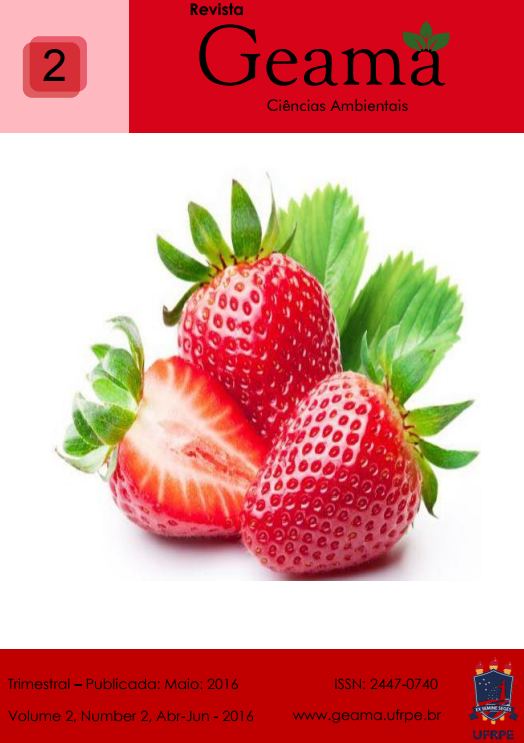Sensing in Detection Parameters Physical Spectral in Urban | Sensoriamento na detecção de parâmetros espectrais Física no meio Urbano
Palavras-chave:
satellite image, NDVI, emissivity, urbanizationResumo
The emissivity and Difference Vegetation Index Normalized (NDVI) are important spectral physical parameters in the study of land surfaces. This article aims to analyze the spectro-temporal point of view the influence of NDVI values in the emissivity of the surface of the urban area of Recife / PE. The work is characterized by multispectral Landsat-5 TM satellite images, the spatial and temporal variation of surface emissivity and (NDVI) in the urban area. The methodology involved the implementation of radiometric correction models, atmospheric and SEBAL Algorithm (Surface Energy Balance Algorithm for Land). We used two images referring to the dates 10 June 1984 and 29 August 2007. The maximum value found for the surface emissivity was 0.982 for 1984 and 0.985 for 2007, the minimum value was 0.971 for the year 1984 and 0.970 in 2007, the average and fashion will not suffer change in 1984 0.974 and 0.973 respectively. The Difference Vegetation Index Normalized presented average values of 0.28% in 1984 and 0.23% for the year 2007. According to the results found there was a decrease of 5.1% of the vegetation cover in relation to the year 1984 being the values of higher emissivity in Pina mangrove in 2007.Downloads
Referências
ALLEN, R.G., TASUMI, M & TEREZZA. R. Sebal (Surface Energy Balance Algorithms for Land) – Advanced Training and User Manual – Idaho Implementation, version 1.0, 2002.
ASRAR, G., MYNENI, R. B. E KANEMASU, E. T. 1989. Estimation of plant canopy attributes from spectral reflectance measurements, Chap. 7. In G. Asrar (Ed.), Theory and applications of optical remote sensing. p. 252–296.
BARET, F. & GUYOT, G. 1991. Potential and limits of vegetation indices for LAI and APAR assessment. Remote Sensing of Environment, v. 35, p. 161- 173.
BASTIAANSSEN. W.G.M., M. MENENTI, R.A. FEDDES e A.A.M. HOTLSLAG, : A remote sensing surface energy balance algorithm for land (SEBAL): 1. Formulation. Journal of Hydrology, vol. 212-213, 198-212, 1998.
CIHLAR, J., TCHEREDNICHENKO, I., LATIFOVIC, R., LI, Z. & CHEN, J. 1997. Impact of variable atmospheric water vapor content on AVHRR data corrections over land. IEEE Transactions on Geoscience and Remote Sensing. v. 39, p. 173– 180.
ELVIDGE, C. D.; CHEN, Z. 1995. Comparison of broadband and narrow-band red and near-infrared vegetation indices. Remote Sensing of Environment, v. 54, (1), p. 38-48.
HUETE, A. R. A soil adjusted vegetation index (SAVI). Remote Sensing of Environment, v. 25, p. 295-309, 1998.
LILLESAND, T.M.; Kiefer, R.W. Remote Sensing and Image Interpretation. Madison: University of Wisconsin, fourth edition, 1999, 750p.
LOPES, P.M.O; Rizzi, R. Modelagem da emissividade da superfície terrestre em regiões montanhosas a partir de dados do sensor Modis. Anais XIII Simpósio Brasileiro de
MARKHAM, B. L. &, J. L. Thematic mapper band pass solar exoatmospherical irradiances. International Journal of Remote Sensing, v. 8, n.3, p. 517-523, 1987
Sensoriamento Remoto, Florianópolis, Brasil, 21-26 abril 2007, INPE, p. 2797-2804
PACHÊCO, A. P. Análise de Métodos de Determinação de Emissividade para Alvos da Superfície Terrestre, na Faixa Espectral de 8 a 14µm. Dissertação de mestrado, INPE, São José dos Campos, (INPE - 4984 - TDL / 394). 1989, 155p.
PACHECO, A. P. Emissividades de superfícies no infravermelho termal. In: IX Simpósio Brasileiro de Sensoriamento Remoto, Santos-Brasil, 1998. Anais, p.1307-1313.
PETERSON, D. L., ABER, J. D., MATSON, P. A., CARD, D. H., SWANBERG, N., WESSMAN, C. & SPANNER, M. 1988. Remote sensing of forest canopy and leaf biochemical contents. Remote Sensing of Environment, p.24, 85 - 108.
RUDORFF, Bernardo F.T. O sensor MODIS e suas aplicações ambientais no Brasil. Editora Parêntese, São José dos Campos-SP, 2007. 423 p.
SALISBURY, J. W & D`ARIA, D. M. Emissivity of Terrestrial Materials in the 8-14μm Atmospheric Window. Remote Sensing Environmental. 42: 83-106, 1992.
VALOR, E.; CASELLES, V. Mapping land surface emissivity from NDVI: application to European, African, and South American Areas. Remote Sensing of Environment, v. 57, p.167-184, 1996.
TOWNSHEND, J. R. G.; JUSTICE, C. O.; SKOLE, D. 1994. The 1 km resolution global data set: needs of the International Geosphere Biosphere Programme. International Journal of Remote Sensing. v. 15, p. 3417-3441.
TUCKER, C. J., TOWNSHEND, J. R. G., & GOFF, T. E. 1985. African land-cover classification using satellite data. Science, v. 227, p. 369–375.
VAN de GRIEND, A. A.; Owe, M. On the relationship between thermal emissivity and the normalized difference vegetation index for natural surfaces. International Journal of Remote Sensing, v.14, p.1119-1131, 1993.
Downloads
Publicado
Como Citar
Edição
Seção
Licença
As Políticas Culturais em Revista aplica a Licença Creative Commons Atribuição-Não Comercial 4.0 Internacional (CC BY-NC-SA 4.0) para os trabalhos que publica. Esta licença foi desenvolvida para facilitar o acesso aberto - ou seja, o acesso livre, imediato, e a reutilização irrestrita de trabalhos originais de todos os tipos. Nossos autores mantêm os direitos autorais mas, sob essa licença, concordam em deixar os artigos legalmente disponíveis para reutilização, sem necessidade de permissão ou taxas, para praticamente qualquer finalidade. Qualquer pessoa pode copiar, distribuir ou reutilizar esses artigos, desde que o autor e a fonte original (Políticas Culturais em Revista) sejam devidamente citados.
![]()






